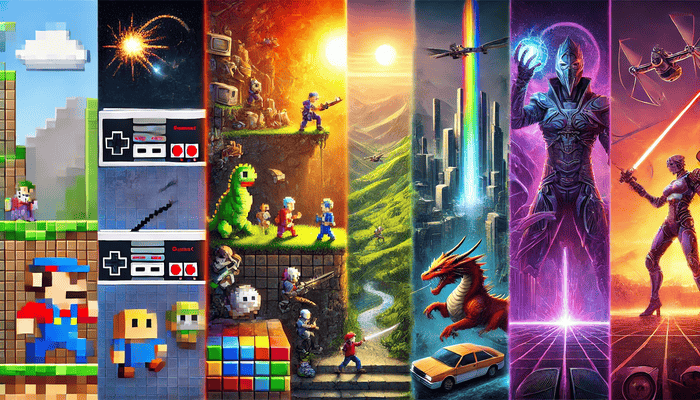Tracing the Visual Transformation of Video Games

Video games have undergone a breathtaking transformation in their visual presentation over the decades. What started as basic pixelated graphics has evolved into hyper-realistic, immersive worlds that rival real life. This journey reflects not just technological advancements but also the creativity and innovation of game developers.
From the simplicity of early pixel art to the stunning realism enabled by advanced hardware, the evolution of graphics in video games is a testament to the industry’s relentless pursuit of immersion and aesthetic appeal.
These advancements have also influenced other industries, such as mobile applications and even cryptocurrency betting, where high-quality graphics enhance user experience and engagement, showcasing the broader impact of visual technology.
The Dawn of Gaming Graphics
The earliest days of gaming graphics were defined by simplicity and ingenuity. Developers worked within the confines of limited technology, using small resolutions and restricted color palettes to create visual experiences that captured players’ imaginations.
Pixel Art and Sprites
Pixel art was the cornerstone of early video games. Each character, environment, and object was meticulously crafted using small, colored squares to form recognizable images. This technique allowed developers to maximize the limited processing power of early gaming systems.
Games like Pac-Man and Space Invaders showcased the creative use of pixel art, relying on iconic designs that are still celebrated today.
In Pac-Man, the maze and characters were built from simple, repeating patterns, while Space Invaders used pixelated sprites to represent alien invaders and spaceships. These games laid the groundwork for future advancements, proving that engaging visuals could be achieved even with significant limitations.
The Shift to 3D Graphics
The transition from 2D to 3D graphics marked a pivotal moment in gaming history. This shift opened the door to new possibilities in visual storytelling and gameplay.
Introduction of Polygonal Models
The adoption of polygonal models revolutionized game design by enabling the creation of three-dimensional objects and environments. Unlike 2D sprites, polygons could be arranged to form shapes with depth, making worlds feel more lifelike.
Games like Super Mario 64 and Tomb Raider were pioneers in this era. Super Mario 64 introduced a fully explorable 3D environment, while Tomb Raider featured a polygonal protagonist, Lara Croft, who moved through richly detailed environments. These innovations demonstrated the potential of 3D graphics to create immersive experiences.
Role of Hardware Acceleration
Advancements in hardware, particularly the development of graphics processing units (GPUs), were instrumental in the evolution of 3D graphics. GPUs allowed for faster rendering and more complex visual effects, making real-time 3D graphics feasible.
Key milestones include:
- NVIDIA’s GeForce series: Introduced hardware specifically designed for gaming, dramatically improving performance.
- Sony’s PlayStation consoles: Brought affordable 3D graphics to the masses.
- PC advancements: Enabled higher resolutions and better frame rates for PC gamers.
These developments set the stage for the next phase of graphical innovation.
Enhancing Realism with Textures and Lighting
As technology advanced, developers sought to enhance realism by improving textures and lighting techniques. These elements added depth and authenticity to virtual worlds.
Texture Mapping Techniques
Texture mapping involves applying detailed images, or textures, to 3D models to give them a realistic appearance. Techniques like bump mapping and normal mapping further enhanced textures by simulating surface details such as wrinkles or scratches.
For instance, in games like The Elder Scrolls V: Skyrim, texture mapping was used to create lifelike environments. The intricate designs on stone walls, foliage, and character armor added depth and immersion to the game’s vast open world.
Advanced Lighting Models
Lighting plays a crucial role in setting the mood and realism of a game. Advanced techniques like dynamic lighting, shadow mapping, and global illumination simulate how light behaves in the real world.
Games like The Last of Us Part II utilized advanced lighting models to create dramatic, emotionally charged scenes. Realistic shadows, reflections, and light diffusion brought the game’s environments to life, enhancing its storytelling.
The Era of High-Definition and Photorealism
The arrival of high-definition (HD) graphics and the push toward photorealism marked another significant leap in the evolution of video game visuals.
High-Definition Resolutions
HD graphics brought unprecedented clarity and detail to games. Resolutions like 720p, 1080p, and eventually 4K allowed for sharper images and more intricate details.
Games such as Red Dead Redemption 2 showcased the power of HD graphics, with landscapes so detailed they felt like living, breathing worlds. The transition to HD also emphasized the importance of art direction and visual storytelling.
Real-Time Ray Tracing
Ray tracing technology represents the pinnacle of realism in video game graphics. By simulating the way light interacts with objects, ray tracing creates lifelike reflections, shadows, and ambient lighting.
Titles like Cyberpunk 2077 and Control have leveraged ray tracing to deliver stunning visuals that blur the line between virtual and real. These advancements demonstrate the potential for further innovation in achieving true photorealism.
Artistic Styles Beyond Realism
While realism remains a dominant trend, many games embrace unique artistic styles to stand out. Stylized graphics prove that creativity can be just as impactful as photorealism.
Stylized Graphics and Their Impact
Games like The Legend of Zelda: Breath of the Wild and Hollow Knight have adopted distinctive art styles that prioritize aesthetics over realism. These games use bold color palettes, imaginative designs, and fluid animations to create memorable experiences.
Stylized graphics often age more gracefully than realistic visuals, as their artistic choices are less reliant on the latest technology. This approach highlights the importance of creativity in game design.
Challenges and Considerations in Modern Game Graphics
As game graphics become increasingly advanced, developers face new challenges and ethical considerations.
Development Costs and Time
Creating high-quality graphics requires significant resources. The development of photorealistic visuals often involves large teams, extended timelines, and substantial budgets. This trend has raised concerns about sustainability in the industry and the pressure it places on developers.
Ethical Implications of Photorealism
The rise of photorealistic graphics also brings ethical questions. Hyper-realistic depictions of violence, for example, can blur the line between entertainment and reality. Developers must navigate these issues carefully to ensure their creations remain responsible and impactful.
Final Thoughts
The evolution of graphics in video games is a journey of relentless innovation and artistic expression. From the pixelated sprites of early arcade games to the photorealistic worlds of today, the progress in visual technology has transformed how players experience games.
As the industry continues to push the boundaries of realism and creativity, it’s clear that the best is yet to come. Balancing technological advancements with thoughtful design and storytelling will ensure that video games remain a powerful medium for entertainment and art.






